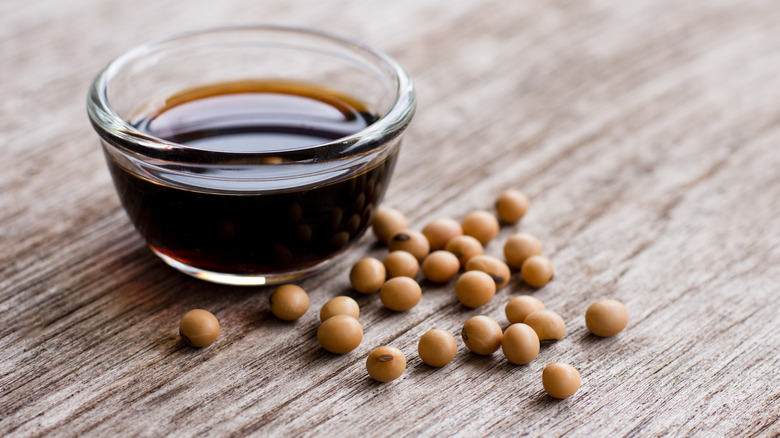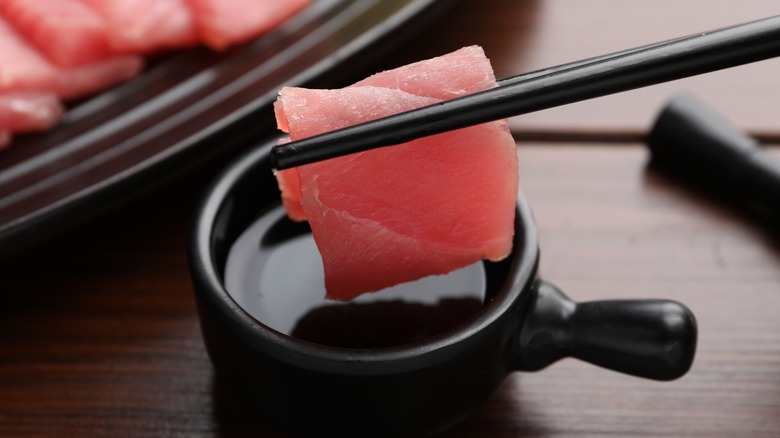What Exactly Is Shoyu And How Does It Taste?
Soy sauce is an indispensable element for crafting a dipping sauce for sushi, forming the foundations for a steaming bowl of udon noodles, or adding depth to a teriyaki marinade. While there are a plethora of soy sauce varieties, not just any ordinary soy sauce will elevate these dishes. Shoyu, shōyu, or 醤油 in kanji characters, refers to Japanese soy sauce. It's an umbrella term used to describe Japanese-style soy sauce. What sets this style apart is the way it's made and the ingredients used.
With its umami flavor and sweet-bitter taste, this sauce boasts remarkable versatility in Japanese cuisine. Shoyu is the perfect soy sauce to use if you want to enhance the taste of any Japanese dish by adding saltiness, accentuating sweetness, or building rich layers of flavor. It's a glorious soy sauce that tends to have a higher wheat content than its Chinese variation.
Whether you've encountered the term "shoyu" in a recipe, spotted ramen named after it, or just find it intriguing, this guide will acquaint you with everything you need to know.
What is shoyu?
With soy sauce's roots being based in China, it's unclear when exactly it came to Japan. The name "shoyu" first appeared in a dictionary in the 1500s, but its usage is likely to have begun in the Muromachi Period (the mid-1300s).
One story claims that a monk named Kakushin brought miso paste back from China in 1254 and, while demonstrating how to make miso, noticed how delicious the excess liquid from this process tasted. Thus, tamari soy sauce was born. It is then believed that shoyu evolved from this, and production began in Japan during the 1600s. Now, there are more than 1,200 shoyu breweries across Japan, creating a multitude of different variations.
From its appearance as a dark, thin sauce, shoyu may seem unrecognizable compared to other soy sauces, but there are subtle differences. Shoyu is typically made using water, salt, koji (mold), and equal parts soybeans and wheat. The fermentation process, called honjozo, matures the ingredients differently from Chinese soy sauce, which is usually chemically brewed and contains little to no wheat. The consistency of shoyu is another subtle difference; it's generally thinner than Chinese soy sauce. It also has fewer ingredients than other soy sauces, which often contain 10 or more components.
The honojozo process
In Japan, honjozo is the traditional method of fermenting soy sauce, which is still used to create about 80% of all Japanese soy sauce today. This process begins by crushing roasted wheat and mixing it with steamed soybeans.
A fungus called koji, or Aspergillus sojae in shoyu making, is added to this mixture to begin the fermentation. Koji contains amylase and glutamate enzymes, which change the starches and proteins into amino acids and sugars. This is what develops the shoyu's umami flavor.
Once the koji is mixed, the mixture is incubated for three days before salt water is added. This mash mixture is called moromi, which refers to the unmatured nature of the soy sauce. The moromi is kept in fermentation tanks to slowly mature for at least six months. Afterward, it's pressed through cloth to squeeze the raw soy sauce out while leaving the ground remnants behind. This is then pasteurized through a process called hiire, which stops the fermentation and standardizes the taste and color. It is then inspected and bottled immediately.
What does shoyu taste like?
Shoyu's main flavor is umami, which translates from Japanese to mean "pleasant savory taste." The origins of the word umami are relatively recent, within the last 100 years. It is often called the fifth food taste, alongside sweet, salty, sour, and bitter. Shoyu's umami character allows it to bring a savory depth to dishes. Yet, alongside umami, shoyu also has a salty, sweet, and bitter disposition. This means it can highlight and contrast different flavors once combined with other ingredients. For instance, with boiled beans, shoyu brings out sweetness while creating a savory backdrop.
Its flavor is not impacted by heating, which makes it such a versatile ingredient, holding its aroma when stir-fried or cooked. The different varieties of shoyu can either lean deeper into the salty, umami, or sweeter aspects of the sauce. Kikkoman produces more than 300 different variations of shoyu, which explore different flavor palates within the sauce, including coffee, whisky, vanilla, and ponzu (citrusy lemon).
Dark shoyu (koikuchi) is commonly used as a condiment on tables, while light shoyu is used as a seasoning. Compared to Chinese soy sauce, shoyu tends to have a thinner consistency, tastes less salty, and finishes with a milder, sweet aftertaste.
Light versus dark shoyu
The two most popular types of shoyu are usukuchi (light) and koikuchi (dark). You may be familiar with light and dark soy sauce, but the differences between light and dark shoyu reveal why the color may be misleading; the color differences do not reflect the amount of saltiness inside.
Koikuchi, dark shoyu, was first developed during the Edo period and is most commonly made using the honjozo method. The long fermentation period allows the sauce to develop a dark color and a rich umami flavor that's both sweet and bitter. It's an everyday soy sauce that can be used to season in cooking, as a marinade, as a condiment, or for dipping.
Usukuchi, light shoyu, should not be confused with low-sodium soy sauce, as its salt content is generally 10% higher than Koikuchi (dark shoyu). For this reason, it should be used to gently season dishes rather than as a dip. In other words, using it to dip sashimi would result in an overly salty mouthful ruining the subtle flavors of the fish. Usukuchi is a lighter brown color and has a slightly fruity and more assertive umami aroma. It's typically used in dishes where you don't want the color of the soy sauce to darken the other ingredients, such as white fish or chicken. Due to the spectrum of tastes shoyu subtly highlights, it's essential to use the correct one to not overpower the other elements in a dish.
How to use shoyu
In its simplest form, dark shoyu can be used as a dip for anything from sushi to sashimi, dumplings to grilled meat. It can also be combined with chopped garlic, ginger, sugar, and mirin to create an irresistible teriyaki sauce. You can also make a shoyu tare that combines sweet mirin, sake, and brown sugar with the shoyu to create a glaze, marinade, or sweeter dipping sauce. If you ever have the pleasure of venturing to Japan, you'll commonly see Shoyu Ramen on the menu. This ramen uses a shoyu tare as the main base seasoning in the noodle soup. It combines the beautiful flavors of pork broth and dashi (a Japanese stock) to celebrate umami.
If a recipe asks for shoyu without a type specification, it most likely means koikuchi. If it specifies usukuchi or light shoyu, consider using it as you would salt to season a dish. It's best in dishes where you want umami flavor without the dark color that koikuchi brings, such as Dashimaki Tamago (Japanese omelets). Usukuchi cannot be used as a substitute for koikuchi, as diluting it to achieve a lighter flavor will only reduce the umami elements of the shoyu.
Generally, soy sauce doesn't need to be refrigerated, but its quality may deteriorate if it's left at room temperature. As shoyu oxidizes, its color darkens, which can pose a problem when using usukuchi shoyu, where maintaining a light color is crucial for its intended use.
Where to buy shoyu
The most common brand of shoyu is Kikkoman, which can be found in Walmart, Target, Whole Foods Market, Costco, and other regional stores. Typically, these stores will supply Kikkoman soy sauce, but an "aromatic shoyu" or "double fermented" shoyu variety is also available. You'll most commonly find shoyu in the condiment or Asian food section. The Kikkoman website provides information on which stores stock certain varieties. If they're unavailable nearby, you can always turn to Amazon. Prices vary from $5 and up.
Otherwise, you can venture to an Asian or international supermarket, which may stock other reputable brands of shoyu, such as Yamaki Jozo, Shoda, Yamasa, or Marukin. One of the most famous brands of shoyu is Kishibori, which is famed for maturing in wooden barrels, resulting in a spectacular aroma and rich, funky taste.
Because we are so lucky to live in an online world, it's also worth checking out Asian grocery websites. Umamicart has a vast selection of shoyu at various price points and with even more intriguing flavors.
Other varieties of shoyu
Although usukushi and koikuchi are the predominant shoyu varieties in Japan, it's essential to note that you may also encounter other types. For example, tamari shoyu has a thicker umami flavor and is much darker than other shoyu varieties. It's made with more soybeans and can have little to no wheat included. Its fermentation consists of a step where it is pressed with miso paste, giving it unique flavor characteristics. Its stronger soy aroma makes it ideal for marinades, but once heated, it also produces a beautiful red hue.
On the other end of the spectrum, shiro shoyu is often described as white soy sauce. With its translucent color, this shoyu has a much milder flavor and weaker umami aroma. It's made with a higher ratio of wheat to soybeans and ferments for a maximum of three months. It's commonly used to flavor udon noodle soup.
If you're in the market for a low-sodium option, genen shoyu can be found with at least 45% less salt than other shoyu varieties. The umaminess is also not compromised and is generally higher than in koikuchi. Mastering the art of using shoyu in your culinary endeavors will undoubtedly open a world of authentic and exquisite Japanese flavors.







